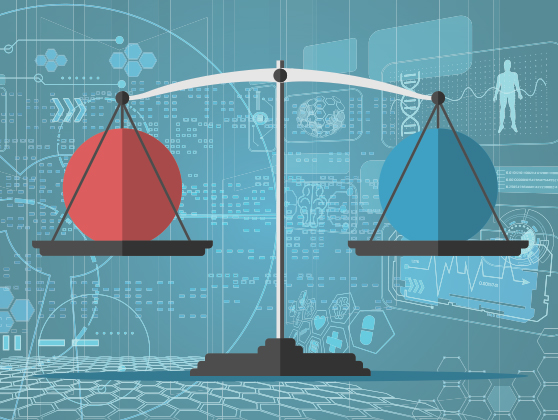
Weighing the Benefits and Risks of Screening. Cancer screening can save some lives, but it comes with the potential for overdiagnosis and overtreatment. Patients should be made aware of the benefits and harms of screening tests to make informed decisions about their health care.
Several recent studies have shown the value of cancer screening in reducing the number of deaths from the disease. One study using computer modeling to estimate the number of cancer-related deaths that could be averted by increasing the use of U.S. Preventive Services Task Force (USPSTF) recommendations for the routine screening of breast, cervical, colorectal, and lung cancers among eligible individuals found significant results in the potential number of lives saved. According to the study’s findings, increasing screening rates for these cancers by just 10% could prevent 1,010 lung cancer deaths, 11,070 colorectal cancer deaths, 1,790 breast cancer deaths, and 1,710 cervical cancer deaths.1
However, the downside to increased screening, according to this study, is it could also lead to significant harms as well, with an estimated 100,000 false-positive lung scans; 6,000 colonoscopy complications; 300,000 false-positive mammograms; and 348,000 cervical biopsies over the lifetimes of those individuals.1

H. Gilbert Welch, MD, MPH
“Typically, we have to screen about 1,000 people for 10 years to avoid one death from cancer,” said H. Gilbert Welch, MD, MPH, a general internist at the Center for Surgery and Public Health at Brigham and Women’s Hospital in Boston, who was not involved in this study. “The harms affect many more people, and that’s why weighing the risks and benefits of screening has to be done carefully. One thing we have to remember is that screening is dealing with well individuals, and we have to be careful when we intervene on well people. It’s hard to make well people healthier; with screening recommendations, we are inducing them to consume medical care, and medical care always comes with risks. Those risks are very acceptable when you are sick and suffering. They are much less accepting when you are well.”
Quantifying the Benefits of Screening
A recent model-based study by researchers at the National Cancer Institute (NCI) using population-level cancer mortality data to determine the contributions of prevention strategies, screening, and treatment interventions to deaths averted from breast, cervical, colorectal, lung, and prostate cancers helps to quantify the benefits of these methods in the number of lives saved. According to the researchers’ analysis, from 1975 to 2020, 5.94 million cancer deaths were avoided for these five cancers combined; 4.75 million of these deaths were averted from cancer prevention and screening efforts alone. Smoking cessation contributed the greatest share in deaths prevented, with 3.45 million from lung cancer alone.2

Katrina A.B. Goddard, PhD
“Although many people may believe that treatment advances are the major driver of reductions in mortality from these five cancers combined, the surprise here is how much prevention and screening contribute to reductions in mortality,” said co-lead investigator of this study Katrina A.B. Goddard, PhD, Director of the Division of Cancer Control and Population Sciences at the NCI, in a statement. “Eight out of ten deaths from these five cancers that were averted over the past 45 years were due to advances in prevention and screening.”3
Assessing the Value of Screening
Still cancer screening alone comes with a hefty price tag. An analysis by researchers at the Division of Cancer Control and Population Sciences at the NCI found the estimated annual cost of initial cancer screening (excluding follow-up costs) for breast, cervical, colorectal, lung, and prostate cancers is $43.2 billion.4 Although that figure represents a large expenditure, it’s substantially less than the national cost for cancer care, estimated to exceed $245 billion by 2030.5 The main driver of this cost is colonoscopy screening, which accounted for 63.6% of the total cost of cancer screening, or $27.5 billion, followed by breast cancer screening, 20.4%; cervical cancer screening, 12.8%; prostate cancer screening, 1.6%; and lung cancer screening, 1.5%.
Most of this expense to the health-care system, according to the study, is covered by private insurance, 88.3%; Medicare, 8.5%; and Medicaid and other government programs and uninsured individuals, 3.2%. The researchers estimated that the cost of cancer treatment in the first 12 months following a cancer diagnosis is nearly $53 billion (in 2021 dollars).4
“In terms of the value of screening for these five cancers, they have been demonstrated in multiple studies to be cost-effective and to decrease cancer-specific mortality,” said Michael T. Halpern, MD, PhD, MPH, FASCO, lead author of this study and currently Professor and Founding Chair, Department of Health Policy and Health Services Administration at The University of Texas School of Public Health, San Antonio. “All five of these types of cancer screenings can increase rates of early detection and early cancer diagnosis, as well as decrease patient financial burden and increase health-related quality of life among individuals who are diagnosed with cancer.”

Michael T. Halpern, MD, PhD, MPH, FASCO
Dr. Halpern continued: “In addition, colorectal and cervical cancer screening can also prevent the development of cancer by allowing for the removal of lesions before they become cancer. So, individuals who are eligible for these cancer screenings based on accepted guidelines and who are unscreened or underscreened should receive information from health-care professionals on the value of screening and be encouraged to be screened.”
Understanding the Limits of Screening
Dr. Welch’s position that the harms sometimes accompanying screening and the potential for overdiagnosis and overtreatment outweigh the benefits is not unfounded, especially for mammography screening. Studies have shown that after 10 years of mammography screening, 50% to 60% of women can expect to have at least one false-positive recall, and between 7% and 12% of those women will undergo at least one false-positive biopsy recommendation.6 The consequence of these recalls is that many women, particularly Asian and Hispanic/Latinx women, are often less likely to return for subsequent mammography screenings if they received a false-positive recall for additional imaging or biopsy. This raises concerns about the continued participation of women in routine mammography screening given the associated increased future risk of developing breast cancer.7
“The broadly held belief is that detecting cancer earlier is always better, but it turns out that cancer is very heterogenous,” said Dr. Welch. “Some cancers progress very rapidly, and those are the ones that are most likely to be missed by screening. Screening tends to find slow-growing cancers that may regress over time and not become a problem. The most aggressive cancers are the very ones that are not detected early because they are growing so fast. That’s not the fault of the mammogram screening. That’s just a bad cancer. And the worst cancers are the ones that screening is going to miss.”
Balancing Individual vs Societal Benefit
What metrics should policymakers and the general population use to assess the value of cancer screening, particularly in a time of diminishing federal funding for health care? This includes considering the potential harms—both physical and financial—such as overdiagnosis, overtreatment, follow-up testing, additional medical procedures, lost wages from time off work, and emotional distress from false-positive test results.

Timothy R. Rebbeck, PhD
“It depends on whether we are talking about individual-level cost benefit or population-level cost benefit,” said Timothy R. Rebbeck, PhD, Vincent L. Gregory Professor in Cancer Prevention and Director of the Zhu Family Center for Global Cancer Prevention at the Harvard T.H. Chan School of Public Health, and Director of Global Oncology at Dana-Farber Cancer Institute. “On a population or societal level, screening will save some lives, but is there a cost beneficial to spend a large amount of money to achieve that goal? For some cancers, such as breast and colorectal cancers, I would say there is a cost benefit, but for other cancers, such as prostate cancer, it’s questionable. But on an individual level, there is no question that some lives will be saved because of screening. If you find the cancer early, some people will not die of the disease. So, screening can have value to the person whose life has been saved. If the goal is to save the maximum amount of lives per dollars spent for society, then the answer is complicated.”
Dr. Halpern agrees. “Well-conducted studies of cancer screening do include evaluations of potential harms, such as overscreening and overdiagnosis, and this has led to changes in how some cancers are treated once diagnosed, particularly for early-stage prostate cancer. For groups for which screening is recommended, there is evidence that the benefits of screening outweigh the harms. Health-care professionals need to concisely summarize the benefits and the potential harms of screening tests to allow patients to make informed decisions about what is right for them based on their values and perceptions of the balance and harms of screening,” said Dr. Halpern.
Optimizing Cancer Screening and Prevention Strategies
In the near future, advances in artificial intelligence (AI) applications in cancer screening may help improve the precision of screening tests, increasing the benefits and reducing the risks for patients. Research is already underway by the National Institutes of Health to enhance the speed, accuracy, and reliability of some methods of cancer screening and detection. For example, the U.S. Food and Drug Administration (FDA) has authorized the marketing of AI-based software called Paige Prostate to help pathologists identify areas of prostate biopsy images that have the greatest likelihood of harboring cancer cells. And NCI-supported research is showing that AI-assisted mammography not only improves breast cancer detection, but can also help to predict the long-term risk of invasive breast cancers.8
Despite these efforts, it will take greater investments in a more multifactorial approach to cancer screening and prevention strategies and in cancer treatment and care to help reduce the estimated 2 million individuals who will be diagnosed with cancer this year in the United States, and the nearly 612,000 individuals who will die of the disease,9 according to Dr. Rebbeck.
“AI will certainly teach us a lot about how to do cancer screening and prevention methods more effectively. But it will also take population studies to help us understand who is going to have very aggressive tumors and is truly at risk of dying of cancer, not just who is being diagnosed with the disease,” said Dr. Rebbeck. “We need multicancer risk stratification that includes social determinants of health and the social drivers that impact who is less likely to get the proper care if they screen positive for cancer. Improving our ability to act on the screening—not only just getting people screened but following up with an accurate diagnosis and quality treatment that’s appropriate for the highest-risk individuals—is crucial. There is a lot of refinement that we need to do before we are really optimizing our screening and prevention potential.”
Putting Resources Into Greater Access to Cancer Care
The introduction of blood-based, multicancer, early-detection tests in the diagnosis of cancers lacking USPSTF-recommended screening has the potential to further exacerbate high false-positive rates, contributing to concerns regarding overtreatment, especially of indolent cancers. The tests, which can interrogate circulating cell-free DNA shed by tumors into the bloodstream and detect a shared cancer signal across as many as 50 tumor types, have not yet received approval by the FDA. Some companies, however, are offering the tests to physicians and patients through the Clinical Laboratory Improvement Amendments program, at a cost of about $1,000, which is currently not covered by insurance.10
“These tests are nowhere near where they need to be to be used effectively, and we don’t have data to show they would reduce cancer mortality,” said Dr. Rebbeck. “The tests are developed to have a very high specificity, so if you have a negative test, it’s very likely you don’t have cancer, so that’s beneficial. But the sensitivity for picking up early-stage cancers is pretty low, just 10% or 15%, compared with later-stage cancers. Still, if these tests could pick up 10% or 15% of ovarian and pancreatic cancers, for which there currently are no screening tests, that would be a huge benefit to patients.”
Rather than investing so heavily in cancer screening tests, those financial resources could be put to better use to ensure that more people have greater access to effective cancer treatment and mitigate the social determinants of cancer risk, including smoking, obesity, poverty, and unhealthy living conditions, argued Dr. Welch.
“To what extent do we want to be monitoring for all the potential things—not just developing cancer—that can go wrong in the future? The path to health is not through more screening. It is through basic health promotion, such as eating real food; getting regular exercise; finding purpose; and, of course, not smoking. The question for any screening test is whether it helps at all, and if it does, does it work well enough to warrant the accompanying unintended side effects? I think we’ve totally overinvested in this strategy,” said Dr. Welch.
DISCLOSURE: Drs. Welch, Goddard, Halpern, and Rebbeck reported no conflicts of interest.
REFERENCES
1. Knudsen AB, Trentham-Diaz A, Kim JJ, et al: Estimated US cancer deaths prevented with increased use of lung, colorectal, breast, and cervical cancer screening. JAMA Netw Open 6:e2344698, 2023.
2. Goddard KAB, Feuer EJ, Mandelblatt JS, et al: Estimation of cancer deaths averted from prevention, screening, and treatment efforts, 1975–2020. JAMA Oncol 11:162-167, 2025.
3. National Institutes of Health: In five cancer types, prevention and screening have been major contributors to saving lives. NIH modeling study looked at the individual and combined impacts of cancer prevention, screening, and treatment. December 5, 2024. Available at www.nih.gov/news-events/news-releases/five-cancer-types-prevention-screening-have-been-major-contributors-saving-lives#:~:text=When%20considering%20each%20cancer%20site,deaths%20averted%20from%20breast%20cancer. Accessed February 27, 2025.
4. Halpern MT, Liu B, Lowy DR, et al: The annual cost of cancer screening in the United States. Ann Intern Med 177:1170-1178, 2024.
5. American Association for Cancer Research: The rising cost of cancer care. Available at www.aacr.org/patients-caregivers/progress-against-cancer/the-rising-cost-of-cancer-care/. Accessed February 27, 2025.
6. Ho TQH, Bissell MCS, Kerlikowske K, et al: Cumulative probability of false-positive results after 10 years of screening with digital breast tomosynthesis vs digital mammography. JAMA Netw Open 5:e222440, 2022.
7. Miglioretti DL, Abraham L, Sprague BL, et al: Association between false-positive results and return to screening mammography in the Breast Cancer Surveillance Consortium cohort. Ann Intern Med 177:1297-1307, 2024.
8. National Cancer Institute: Artificial intelligence (AI) and cancer. Available at www.cancer.gov/research/infrastructure/artificial-intelligence. Accessed February 27, 2025.
9. National Cancer Institute: Cancer stat facts: Common cancer sites. Available at https://seer.cancer.gov/statfacts/html/common.html. Accessed February 27, 2025.
10. National Cancer Institute: Questions and answers about multi-cancer detection tests. Available at https://prevention.cancer.gov/major-programs/cancer-screening-research-network-csrn/questions-and-answers-about-multi-cancer. Accessed February 27, 2025.

